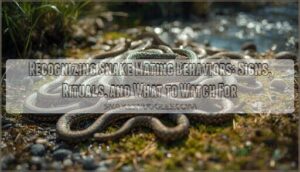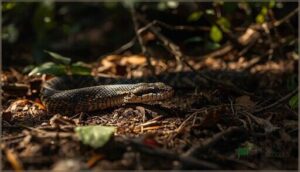This site is supported by our readers. We may earn a commission, at no cost to you, if you purchase through links.

Picture a lazy spring afternoon by the river, and suddenly the ground ripples—hundreds of snakes weaving in a living knot, each one swept into a centuries-old ritual. Beneath the scales and silent movement lies a world of fierce competition and subtle signals: restlessness, shimmering colors, and touch-driven dances that few ever witness.
Recognizing snake mating behaviors isn’t just a curiosity; for field herpetologists and cautious hikers alike, it’s a window into the secret lives of these misunderstood reptiles. Once you know what to watch for, every flicker of movement becomes a clue in nature’s annual mystery.
Table Of Contents
Key Takeaways
- Snake mating behavior is most obvious through increased activity, the dramatic formation of mating balls, and subtle color shifts during spring.
- Male snakes compete for mates with combat dances, pheromone trails, and intricate coiling rituals, while females signal readiness through cloacal gaping and selective behavior.
- Environmental cues like temperature, daylight, and food availability tightly control when and how snakes breed each season.
- Many species rely on unique adaptations such as sperm storage and copulatory plugs to boost reproductive success in challenging or unpredictable environments.
Key Signs of Snake Mating Behavior
If you know what to look for, snake mating season tells its own story. Certain signs signal when snakes are gearing up for romance.
Here are a few behaviors you’ll want to watch for.
Increased Activity and Movement
You’ll almost always spot snake mating behavior by noticing a sudden spike in activity. Males expand their mate-searching range, traveling farther and more frequently thanks to environmental cues like warming temperatures.
This increased activity pushes energetic costs and ramps up risks—from road mortality to predation. Movement success is the ticket to reproduction, making restless wanderers key signs of snake mating behavior.
For example, male garter snakes experience shortened telomeres due to intense mating investment.
Formation of Mating Balls
If you spot a knot of snakes entwined together, you’re looking at one of the most dramatic signs of snake mating behavior: the formation of mating balls. These aggregations—sometimes with dozens or even hundreds of males—compete fiercely for a single female.
A knot of entwined snakes signals the dramatic spectacle of mating balls, where dozens of males compete fiercely for a single female
Driven by environmental influences, these mating balls can be observed where garter snakes congregate. Here, duration dynamics and male combat define which genes move forward, shaping reproductive success.
Changes in Color or Sheen
During snake mating season, you might notice subtle but striking changes in color—think deeper hues, more gloss, and even shifts in pattern. This surge in iridescence intensity and adaptive coloration often results from hormonal influences.
Sexual dichromatism, though rare in snakes, highlights fascinating geographic variation. These visual cues are among the more eye-catching snake mating signs tied to courtship rituals.
Synchronized Breeding Patterns
While those shifting colors might catch your eye, keep an ear to the ground for synchronized breeding patterns too. When environmental cues line up—like temperature swings after winter—breeding aggregations form almost on schedule.
Mating aggregations, often called “mating balls,” bring together dozens of snakes, proving that geographic variation and even phylogenetic links shape these extraordinary synchronized breeding events across species.
Snake Courtship Rituals and Displays
Snake courtship is full of fascinating moves and surprising displays. From subtle gestures to dramatic encounters, these rituals shape which snakes get to mate.
Here’s what to watch for when courtship becomes the main event.
Male Combat and Dominance Displays
Ever seen a “male combat dance” in snakes? It’s tough, strategic, and often mesmerizing. Males intertwine, wrestling to establish a dominance hierarchy, flashing behavioral displays like raised forebodies and tail jerks.
Energy investment here isn’t wasted—winning males secure better mating privileges. Combat techniques and styles even vary by species, with some truly theatrical territorial displays in play.
Pheromone Trails and Scent Marking
When you look at the courtship game among snakes, pheromone trails are the secret messages written in invisible ink. Scent marking isn’t just about location—it’s social chemistry in action. Each chemical signal whispers clues about a female’s status, with males using their tongues to decode:
- Pheromone composition hints at reproductive readiness
- Trail longevity influences mate location success
- Behavioral modulation shapes who gets the girl
Body Undulations and Tail Quivering
When you witness courtship rituals, notice the rhythmic body undulations—a classic element in snake mating behavior. These body shudders, paired with rapid tail quivering, unfold in a precise behavioral sequence.
Different species adjust their undulation mechanics and quivering frequency, but the result is similar: stimulating the female, boosting mating signals, and giving you telltale snake mating signs to spot.
Mating Dances and Coiling Behavior
Ever notice snake courtship rituals that look like a slow-motion dance? That’s no accident—mating dances start with subtle body alignment and ramp up to dramatic coiling behavior, sometimes lasting up to 45 minutes.
When Movement Synchronization occurs, mating success jumps. Across species, dance initiation and coiling duration reveal key snake mating signs you can spot during peak breeding season.
Chin Rubbing and Neck Biting
Could Tactile Communication be the secret handshake of snake mating behavior? For many colubrid species, chin rubbing sets the mood—males glide their chins along the female’s body, a move proven to boost Mating Success.
Neck biting, however, packs a punch in courtship rituals, with its Evolutionary Significance and Species Specificity influencing Behavioral Variation in physical courtship displays across lineages.
Female Snake Behavior During Mating
Watching female snakes during mating season can be surprisingly revealing if you know what to look for. Their behaviors shift in subtle but noticeable ways, each signaling a different stage in the process.
Here’s what you’ll want to pay attention to next.
Cloacal Gaping and Receptivity Signals
You might be surprised, but cloacal gaping is a nearly universal cue in snake mating behavior—think of it as the “green light” for mating success. Triggered by pheromone induction and male courtship, this response in female receptivity is measured in behavioral assays and tracked by stress markers, revealing deep evolutionary origins in reproductive behavior and precise cloacal alignment.
Reduced Feeding and Resting Patterns
Once a female signals receptivity, her snake behavior shifts—reduced feeding and resting modification kick in. This isn’t laziness; it’s smart Risk Reduction. Gravid anorexia helps avoid predators, while metabolic shifts fuel Energy Allocation to developing eggs.
During courtship rituals and active mating behavior, females eat less and rest less, all to improve reproductive behavior and protect those future hatchlings.
Selection of Dominant Males
Once feeding slows down, your attention shifts to which male snakes are winning the contest. Combat advantages become obvious: larger, stamina-packed males outlast rivals with bold dominance displays.
Females lean into pheromone preference, sizing up suitors during these heated bouts. Selecting size dominance and persistence boosts genetic benefits—ensuring only males with top stamina selection, sharp mating competition skills, and proven mating success pass on their genes.
Sperm Storage and Fertilization
After a dominant male finally succeeds, the story isn’t over—snake sperm heads for long-term storage. You’ll find that storage duration can run from months to nearly seven years, ensuring sperm viability. Sperm storage and fertilization even allow for multiple paternity. These adaptations—sperm morphology, sperm plugs, and delayed fertilization—all offer your snakes an evolutionary advantage in unpredictable environments.
- Sperm transfer is followed by genetic material transfer, not immediate fertilization.
- Storage duration can break vertebrate records—years, not just months.
- Sperm viability is preserved by specialized oviduct tubules.
- Multiple paternity often results, as sperm from various males compete.
- Sperm morphology and plugs prevent premature sperm loss—a key to evolutionary advantage.
Mating Mechanics and Anatomy
Regarding snake mating, there’s more happening than just fancy dances and flickering tongues. The mechanics behind their courtship are just as fascinating as the rituals themselves.
Here’s what you can expect to see when snakes get down to business.
Hemipene Structure and Function
Hemipene morphology in snakes is fascinating—each male is equipped with two hemipenes, hidden at the base of the tail and expertly everted one at a time during mating.
These organs, with unique hooks or spines, guarantee secure hemipene insertion into the female’s cloaca. Eversion mechanics aid sperm transfer, sometimes creating mating plugs.
Scientists even use hemipenes as taxonomic characters.
The Copulation Process
When snakes get down to business, precision is everything. First comes delicate Cloacal Alignment, then the male wraps tight for Hemipenis Insertion—his hemipenes expertly locking into the female’s cloaca. Stay alert for these hallmarks:
- Tactile weaving and tail locking
- Hemipenis insertion for sperm transfer
- Copulatory Plug formation
- Calm post-copulation separation
This process is all about timing and teamwork.
Duration of Mating Sessions
Curious how long these intimate sessions last? Duration of mating in snakes is a masterclass in species variation: anywhere from a fleeting minute to over 20 minutes.
Influencing factors run the gamut—physical mechanics of mating, copulatory plugs, and female responses all play a role.
Extended courtship duration and prolonged courtship rituals aren’t just showmanship—they boost reproductive success through sperm competition and adaptive traits.
Physical Locking and Body Positioning
During mating, you’ll notice remarkable teamwork and tension—male and female bodies wrap tightly in a mating knot, tails intertwined for maximum cloacal engagement. Hemipene insertion often sparks visible body compression, while hemipene spines anchor males through sexual conflict. Successful copulation creates copulatory plugs, all guided by precise coiling behavior and the physical mechanics of mating—nature’s choreography in action.
- Tails intertwined, bodies pressed close
- Spine-anchored hemipenes resist female rolls
- Mating knot maintains physical locking
- Copulatory plugs form after sustained engagement
Environmental Cues Influencing Mating
Snakes pick up on a surprising mix of cues from their environment when it’s time to mate. Everything from changes in temperature to shifts in food supply can spark their breeding instincts.
Here’s what really shapes those mating behaviors.
Temperature and Daylight Triggers
Think of temperature and daylight like nature’s backstage crew—quietly setting the mood for snake romance. You’ll see breeding triggered only after certain “thermal thresholds” and photoperiod effects are met.
Environmental cues, from dormancy transitions to sudden warmth, cue snakes that it’s showtime. Even in captive breeding, mimicking these climate impacts is key for reproductive success.
Seasonal Timing of Mating
Need proof that timing is everything? The snake mating season is tightly choreographed by environmental cues—mostly temperature and daylight. In temperate regions, breeding season peaks in spring, while tropical breeding can stretch across months.
Thanks to climate change, phenological shifts now nudge some snakes to mate earlier or cluster breeding windows, as abiotic factors like rainfall or warmth set the biological clock.
Prey Abundance and Habitat Quality
Consider this: every snake breeding season is an ecological balancing act. Your ability to spot key influences on mating comes down to watching three things:
- When prey availability surges, more females reproduce and neonates thrive.
- Declines in food availability drop reproductive timing and snake body condition.
- Habitat degradation reduces prey abundance, shrinking mating opportunities and long-term reproductive success.
Impact of Climate Patterns on Reproduction
Just as prey and habitat tip the scales, climate patterns play a starring role in snake reproduction. Fluctuating temperature and rainfall can trigger Thermal Stress, Drought Effects, or even shift breeding ranges.
Warmer springs may set the stage early, but unchecked heat or dry spells disrupt maternal condition and timing, creating a risky phenological mismatch for newborns.
Frequently Asked Questions (FAQs)
Can snakes reproduce through parthenogenesis in the wild?
Yes, wild parthenogenesis absolutely occurs in snakes. Some species can produce offspring asexually, resulting in genetic homozygosity.
However, asexual lineages often face fitness consequences, shaping the evolutionary context of asexual reproduction in snakes and genetic diversity.
How do snake mating behaviors differ by species?
You’d think all snakes waltz the same way, but that’s far from true! Snake mating behaviors weave a tapestry of ritual variations, anatomical adaptations, and species-specific courtship signals—driven by reproductive strategies, genetic diversity, and environmental influences across species.
What risks do snakes face during the mating season?
During mating season, snakes run a gauntlet of hazards—predation spikes, mating competition, and injury risks rise sharply.
Add disease spread, energetic stress, and habitat threats, and it’s a tough test for both parents and offspring survival.
Do all female snakes care for their eggs or young?
Imagine a python curled tightly around her eggs, offering maternal care rare among snakes. Most show little parental care—oviparity brings egg mortality risks, while python brooding boosts egg incubation and hatchling dependency, shaping maternal investment and offspring survival.
Why do some snake species skip a breeding season?
Some snakes skip breeding seasons when energy reserves run low, prey abundance drops, or environmental conditions turn harsh.
Younger or smaller females are especially likely to pause reproduction due to hormonal changes, food availability, temperature, and climate effects.
Conclusion
It’s no small feat to play matchmaker for serpents, but recognizing snake mating behaviors can make you feel like a herpetological Sherlock Holmes. Watch closely, and you’ll spot the subtle courtship choreography—like snakes forming a ballet troupe with zero sense of rhythm.
These rituals aren’t mere curiosities; they’re key cues for understanding reptile survival strategies. You’ll never look at a sun-warmed log quite the same way again, now that you know just what might be wriggling underneath.
- https://pubmed.ncbi.nlm.nih.gov/4006433/
- https://en.wikipedia.org/wiki/Sexual_selection_in_scaled_reptiles
- https://digitalcommons.usu.edu/cgi/viewcontent.cgi?article=1469&context=honors
- https://masonlab.ib.oregonstate.edu/sites/masonlab.ib.oregonstate.edu/files/128Shine%202012%20-%20An%20airborne%20sex%20pheromone%20in%20snakes.pdf
- https://news.oregonstate.edu/news/snake-research-passes-mating-milestone














